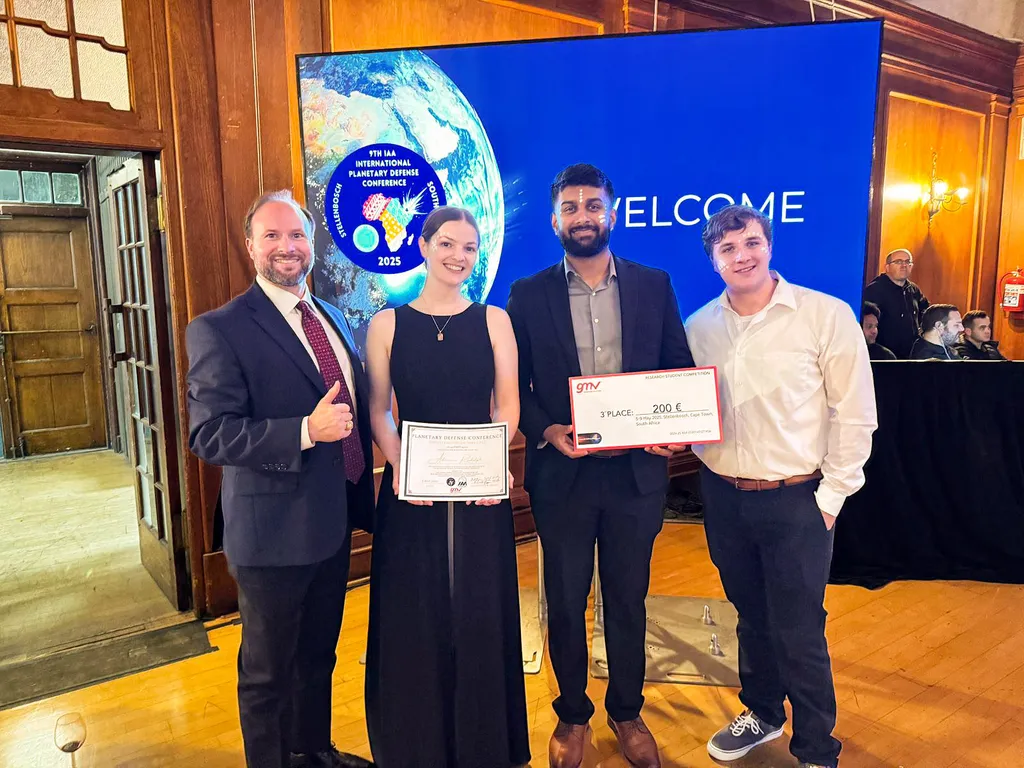- August 22, 2025
- By Jennifer Figgins Rooks
When the asteroid Apophis misses Earth by a whisker in April 2029, aerospace engineering students at the University of Maryland plan to be right on target.
A UMD team of graduate students is refining a mission concept that could put a university-built spacecraft in position to capture close-range images and data from the asteroid to offer valuable information on its structure and behavior.
The launch of TERP RAPTOR (Terrapin Engineered Rideshare Probe for Rapid-response Asteroid Apophis Profiling, Tracking, Observing, and Reconnaissance), would deepen understanding of how the solar system and planets formed while providing insight about defending Earth from other threatening asteroids.
The proposed mission originated as a student project in a graduate course taught by lecturer Brent Barbee, the lead planetary defense applications scientist and community liaison at nearby NASA Goddard Space Flight Center.
UMD’s proposed mission would launch a breadbox-size satellite into Earth orbit as a ride-along with other spacecraft, then conduct a high-speed flyby of Apophis on April 13, 2029, as it passes within roughly 32,000 kilometers (20,000 miles) of Earth, a distance closer than many geosynchronous satellites. This proximity to Earth offers a rare opportunity for detailed observations of how Earth’s gravity field affects an asteroid’s composition, rotation, and structural response; it will also be visible to the naked eye in the night sky from Europe, Africa, and parts of West Asia.
Scientists have been monitoring Apophis, which measures an estimated 340 meters in diameter, since its discovery in 2004. Current trajectory data shows no Earth impact risk on subsequent fly-bys for at least a century.
Proposed federal budget cuts could eliminate a major mission to rendezvous with Apophis—NASA’s OSIRIS-REx spacecraft, renamed OSIRIS-APEX. But, OSIRIS-APEX cannot get up close to Apophis until June 2029, long after Apophis’s visit to our home planet. So, even if OSIRIS-APEX’s budget is restored, university-led initiatives like UMD’s TERP RAPTOR are among the few viable opportunities to collect close-up data during Apophis’s visit to Earth.
“Apophis represents both a scientific gift and a planetary warning,” said Barbee. “It reinforces our guiding impulse to aim for the stars, while organizing our thinking and efforts like nothing else can. And while it offers an incredibly rare chance to deepen our understanding of near-Earth asteroids, it also reminds us that these asteroids carry incredible potential for destructive force if they should ever impact Earth.”

In May, the team presented its mission design at the International Academy of Astronautics Planetary Defense Conference in South Africa. Its paper placed third in the student competition, earning a modest prize and substantial positive feedback from conference attendees. Contributing team members include UMD Ph.D. student Adrienne Rudolph M.S. ’25; alumni Chinthan Prasad ’23, M.Eng. ’25, Cameron Storey ’23, M.Eng. ’25 and Rahul Vishnoi ’23, M.S. ’25; M.Eng. student Sean Philips ’24; Ph.D. student Kruti Bhingradiya ’24; Department of Aerospace Engineering faculty members Brent Barbee, David Akin, Mary Bowden and Jarred Young; and Department of Astronomy faculty Lori Feaga.
The team secured a grant from the Maryland Space Grant Consortium to continue refining its design, conduct ground testing of prototype camera systems, and continue advancing early-stage development through December.
“The analogy that I like to use, said Rudolph, who leads the graduate student team, “is that this opportunity to see Apophis is like going to the zoo to see a tiger, bear, or some other large animal. Apophis is a beast the world will safely get to observe from behind the glass of our camera. It’s terrifying to think of what it would do if it were to harm us, but it won't harm us, so it’s worth going to see. In a way, TERP RAPTOR will be bringing the zoo to the people.”
The team is now in the process of refining its design and expanding its roster. Its Fall 2025 semester goals include prototype testing and preparing to take the next steps in securing the resources needed to be ready to fly to Apophis.
“It’s no wonder that Apophis captures our imaginations and inspires our students so deeply,” said Barbee. “In their work on TERP RAPTOR, our University of Maryland students are fearlessly leading the way on the global stage in their very ambitious quest to reach Apophis, and to expand human presence in space.”
Team members presented their mission proposal at the International Academy of Astronautics Planetary Defense Conference in South Africa earlier this year. From left: Brent Barbee, Adrienne Rudolph, Chinthan Prasad and Sean Philips.